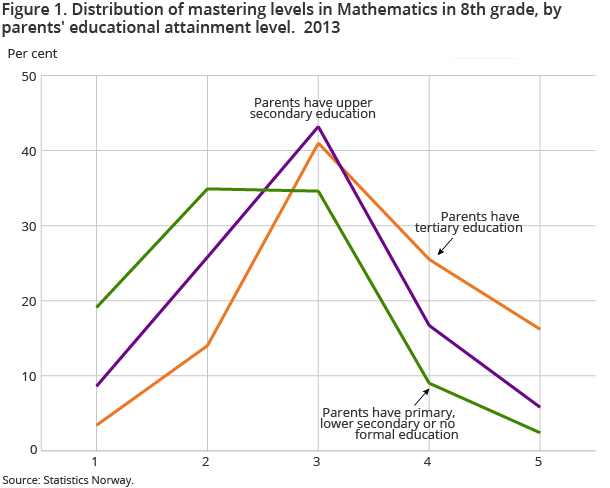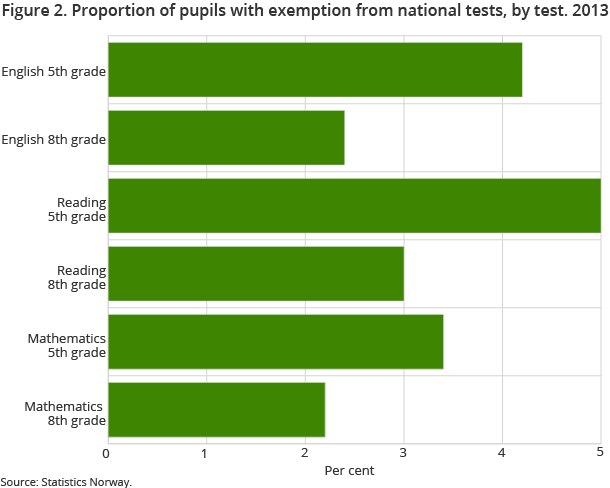Content
Published:
This is an archived release.
Geographical differences
The results from national tests in 2013 differ significantly across the counties. Sex, social and immigrant background continue to vary with pupils’ results.
| 2013 | |||
|---|---|---|---|
| Proportion of pupils who achieved the lowest level. English 5th grade | Proportion of pupils who achieved the lowest level. Reading 5th grade | Proportion of pupils who achieved the lowest level. Mathematics 5th grade | |
| All pupils | 25.8 | 24.2 | 26.7 |
| Sex | |||
| Boys | 27.3 | 26.2 | 25.9 |
| Girls | 24.3 | 22.1 | 27.5 |
| Immigration category | |||
| Immigrants | 29.1 | 39.9 | 43.5 |
| Norwegian-born to immigrant parents | 25.7 | 36.8 | 40.4 |
| Other pupils | 25.6 | 22.3 | 24.6 |
| Parents' educational attainment level | |||
| Parents do not have tertiary education | 33.9 | 34.1 | 38.1 |
| Parents have tertiary education | 19.9 | 16.5 | 18.0 |


Pupils in Oslo and Akershus counties achieve higher results in all tests compared with the national average. In all tests in 5th grade, there are 10 percentage points more pupils who achieve the highest mastering level in Oslo, compared with the national average. In English and Mathematics in 5th grade, 36 and 35 per cent of all Oslo-pupils achieved the highest mastering level compared with 25 per cent nationally.
Parents’ level of education has impact on results
As observed in previous years, there is a positive correlation between parental level of education and achieved test results. Pupils who have parents with tertiary education are more likely to achieve a high mastering level in all tests compared with other pupils. One third of all pupils who have parents with tertiary education achieved the highest level at the Mathematics test in 5th grade. In contrast, only one out of ten pupils who have parents with primary or lower secondary school achieved the same.
Immigrants achieve lower results except in English 5th grade
Immigrants and Norwegian-born to immigrant parents on average achieve lower scores compared with other pupils. The only exception is the English test in 5th grade, where pupils with immigrant background achieved higher scores compared with other pupils.
Girls achieve higher in reading
On average, girls achieve higher results than boys in reading. In English the differences between boys and girls are less pronounced. Boys achieve higher results in Mathematics.
Progress in 9th grade
Pupils in 8th grade and 9th grade are given the same test in reading and Mathematics. A comparison between the test results of the two grades shows that pupils in 9th grade achieve higher results in both tests. A third of all pupils in 8th grade achieve a high level in reading, while close to half of all pupils do the same in 9th grade.
Exemption from national tests
Pupils who receive special education or additional language training can be exempted from national tests. The lowest exemption rate was in Mathematics 8th grade, where two percent of the pupils were exempted, while the highest exemption rate was in reading in 5th grade where five percent of the pupils were exempted (see figure 2)
Mastering levelsOpen and readClose
The results of the national tests are presented here as shares of the percentage at different mastering levels. The tests in 5th grade range from 1 to 3 (3 is highest), whereas the tests in 8th and 9th grades range from 1 to 5 (5 is highest). In order to make it easier to compare the results between the two different grades, a “low level” in 8th grade will, by definition, mean the same as mastering level 1 or 2, a “medium level” in 8th grade will mean 3, and a “high level” in 8th grade will mean 4 or 5.
More detailed information about the levels and boundaries between levels is available in About the statistics .
The statistics is now published as Marks and national tests, lower secondary school.
